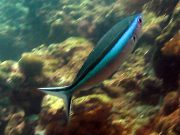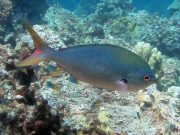Fusiliers (Caesioninae) are closely related to tropical snappers (Lutjaninae) and are easily spotted while diving around Koh Lanta.
Although they share a number of similarities with snappers, they are generally more slender and have a small and distinctly different jaw which allows the mouth to be protruded or extended (known as 'protrusible'). Fusiliers often congregate in large zooplankton feeding schools in mid-water over the reef.
The body is fusiform (tapering at both ends, almost spindle-shaped) with weak spines and a deeply forked tail. The body scales run horizontally in rows and most species have scales on their dorsal and anal fins. Fusiliers can be up to 50 cm, but more commonly observed 15 - 25 cm.
This family have relatively large eyes and the eye diameter can be longer than the length of the snout. Fusiliers may have stripes running their entire length and the tail fin is typically either without any markings, or else has black lobes or streaks in the middle of each tail lobe.
3 species found on this page.
Wide-Band Fusilier
(Pterocaesio lativittata)
Pterocaesio lativittata @ Hin Bida
The Wide-Band Fusilier has a silvery-blue body and a yellow stripe from above the eye to the tail base. The tail fin lobes have dark tips.
The Wide-Band Fusilier grows to 20 cm, but more usually observed in the 10 cm - 15 cm range.
This species forms large schools and can be found on steep reef slopes or in deeper water close to reef areas. The diet consists of zooplankton.
Bluestreak Fusilier
(Pterocaesio tile)
Pterocaesio tile @ Koh Haa
The Bluestreak Fusilier has a silvery blue body. The upper body is dark, followed by a black stripe which runs to the upper tail lobe, followed by a blue-green streak which runs from the eye to the tail base.
The lower body is a lighter colour, varying from white to pinkish, which can turn red at night.
The Bluestreak Fusilier grows to 25 cm and often forms schools, sometimes mixing with other fusilier species.
Feeds mainly on zooplankton.
Yellowtail Fusilier
(Caesio cuning)
The Yellowtail Fusilier, or Redbelly Yellowtail Fusilier as it is also known, has a silvery-blue to bluish-green upper body, and a white or pinkish belly.
The yellow tail fin is forked and may have a pinkish tinted area in the middle. The dorsal fin is greyish-blue to the front, and more yellowish to the rear.
The Yellowtail Fusilier is typically observed in the 20 cm - 25 cm range, but can grow to 50 cm. This species can form schools in mid-water and fees on zooplankton.



